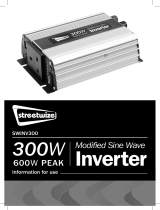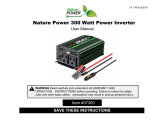
14
TROUBLESHOOTING/FAQ:
Q. Why does the inverter turn itself off?
A. If the inverter’s audible alarm sounds and a fault L.E.D illuminates, this indicates that
there is a fault or error, and the inverter may turn off. Most commonly this would be
caused by an appliance that is drawing too much power (overloading), low battery
voltage or voltage drop due to insufficient size cables or poor connections (refer to
‘Faults & Errors’ table, page 12).
Q. The Inverter will not run my appliance even though the appliance draws less
power (Watts) than the size of the inverter?
A. Electrical appliances can be divided into three groups by the way they draw energy
(current) from their power supply. These groups are “Resistive”, “Inductive” and
“Capacitive” appliances or also called “loads”. Some appliances may draw all three
types of power.
Resistive Loads such as normal incandescent lights (wire filament) always draw
a constant power (watts) from the power supply, that is a 100 Watt light will draw
approximately 100 Watts from the power supply at all times. Resistive loads are the
easiest appliances for an inverter to run.
Inductive Loads such as a refrigerator (Electric Motor) require a large rush of power
(surge current) to start and then usually draw a more constant power once running.
Inductive loads contain coils of wire (motors, transformers, ballasts, solenoids). When
the power is first turned on, these coils of wire draw a large surge current which forms
the magnetic flux (magnetic field) which allows these appliances to work. This magnetic
flux is a kind of stored energy.
The most common inductive appliances are: fridges, air compressors, transformers/
chargers, pumps, power tools and fluorescent lights. These appliances can draw up to
10 times their normal running power to start up; that is to run a 80W fridge you may
need a 600 or 1000 Watt inverter.
Capacitive Loads such as many TV’s or many electronic appliances require a large surge
current to start only when they have not been used for a while. This is often due to large
capacitors in the power supply that must be quickly charged when the appliance is turned
on. If the appliance is not used for a few days these capacitors slowly go flat. Resetting
the inverter a couple of times may allow these appliances to work.
There are some appliances such as large refrigerators, air conditioners and other pump
driven appliances that have extremely high start up currents, because they have an
inductive motor that must start under load. These appliances are not recommended
for use with an inverter. They should be powered by an engine driven generator.
IP150-1000 Instruction Manual_1 3/02/12 11:01 AM Page 14

















